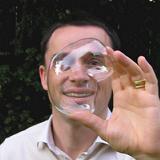 |
|
|
|
| Author |
Message |
NigelT
Site Admin

Location: Wellington
|
 Posted: Thu Jul 05, 2007 10:04 am Medieval Shoes Posted: Thu Jul 05, 2007 10:04 am Medieval Shoes |
 |
|
Griff posted this elsewhere on the site - thought it might be of interest to anyone looking for shoes that can't be bothered making them.
| griff wrote: |
http://www.awlleather.com.au/al_med_shoes.html
this guy makes really good shoes if your not into making them yourself.
the prices may a bit steep for the newbie. But the are really good shoes.
i was lucky enough to have a pair grfted to me.
good sturdy waterproof , safe on any terrain snow included, they have been through a couple of mean frosts but no actual snow so that has yet to be tested but i think they would stand the test.
also no slipping and sliding on hall floors because they have a thin rubber sole.(sshhh) |
On that topic - does anyone have any other good shoe resources or patterns? Nearly every pair I've ever seen hand-made look somewhat lacking in waterproofing and comfort. Is this a period thing or just a matter of using the right pattern and technique?
Nigel |
|
|
 |
griff

Location: Auckland
|
|
|
 |
wuzzle
Location: levin
|
 Posted: Thu Jul 05, 2007 10:08 pm Re: Medieval Shoes Posted: Thu Jul 05, 2007 10:08 pm Re: Medieval Shoes |
 |
|
| NigelT wrote: | Griff posted this elsewhere on the site - thought it might be of interest to anyone looking for shoes that can't be bothered making them.
| griff wrote: |
http://www.awlleather.com.au/al_med_shoes.html
this guy makes really good shoes if your not into making them yourself.
the prices may a bit steep for the newbie. But the are really good shoes.
i was lucky enough to have a pair grfted to me.
good sturdy waterproof , safe on any terrain snow included, they have been through a couple of mean frosts but no actual snow so that has yet to be tested but i think they would stand the test.
also no slipping and sliding on hall floors because they have a thin rubber sole.(sshhh) |
On that topic - does anyone have any other good shoe resources or patterns? Nearly every pair I've ever seen hand-made look somewhat lacking in waterproofing and comfort. Is this a period thing or just a matter of using the right pattern and technique?
Nigel |
I once down loaded and pattern made a set of 10th cent townsmans shoes
having created esentually 2 `bags i later found (having recycled leather)
I had not printed page 4 the page that described the `stuffing of wool and or straw, talk about newbe bored in shed!
but...kermit the beserk
not I
see jeremy his shoes are very tidy and comfortable BUT also not snow tested |
|
|
 |
Boyd

Location: London
|
 Posted: Mon Jul 09, 2007 9:16 pm Posted: Mon Jul 09, 2007 9:16 pm |
 |
|
I've used this site with success
Making Medieval Arrowheads by Martin Austwick
http://www.the-exiles.org/essay/makingmedishoes.htm
The pattern making section is easy to do and can be done on the cheap.
For those who aren't interested in making vegetanned leather shoes or buying expensive thick leather to sew, this pattern will work on 1mm thick leather. It can be either hand stitched using glovers needles (you don't need to buy an awl) or a sewing machine that can handle leather. Using the thin leather also means that there is no Edge/Flesh stitching
The shoes are wide in the 'waist' (under the arch) but are good for people who require orthopedic support.
It's also a easy way of making shoes for children that won't break the bank.
I have found these shoes to be comfortable, dry quickly when wet, and my prototype pair (with a PVC glued sole insert of leather) have survived dancing and combat on wooden floors, walks on metal roads, tarseal, concrete and aggregate, as well as grass. They don't handle mud that well as they get slippery.
This pattern can be used to make lace up shoes, latchet shoes and boots, even poulaines.
Please view Marc Carlson’s site for styles of shoes (website in an earlier posting)
I tried using this technique, without using any of my leatherworking equipment, and using items that most people should be able to access from craft shops.
Craft-knife, Glover’s Needles, 2 Normal sewing needles, thread (I like Gutterman’s Linen, but cotton will work), beeswax for waxing the thread, emery paper, Ados F5 Glue (I prefer the gel product).
If you do use thin leather:
I used two thin pieces of leather, glued flesh side to flesh side to make the sole.
If you do lots of dancing inside I suggest keeping the bottom of the sole smooth (I have found the grip on my shoes to grip inconveniently when dancing on wood an lino!) If you want more grip for outside wear or combat then before gluing; cut long, thin strips of the leather. Make short slits in the sole at the ball of foot and the heel, and weave the strips into the sole. You will then have a loose checkerboard effect on the bottom of your sole with raised pieces of leather. It may not look like much but it is surprising how much grip you get. Then glue the pieces together flesh to flesh
Sew the upper piece and the heel piece together.
The sole piece and the upper & heel piece can be sewn using 'saddle stitch' through all 3 pieces of leather. I suggest starting at the toe point and working down either side to the around the ankle.
You can use a Glover’s needle as your awl, but the sides of the triangular point need to be sanded with your emery paper.
The points of your normal sewing needles will need to be blunted.
Aim for stitches every 3-4mm. A shoe should take around 4-5 hours of hand stitching (with breaks!)
This design needs a heel stiffener, please include in your shoes or you will get damage on the bottoms of your heels.
The shoes can be water proofed with Dubbin, and nuggeted when they look shabby. If you want really waterproof shoes glue all the inside of the seams with Ados F5.
_________________
Experience is not what happens to a man; it is what a man does with what happens to him.
Aldous Huxley in "Texts and Pretexts", 1932 |
|
|
 |
White Knight

Location: Orcland
|
 Posted: Wed Sep 05, 2007 11:20 pm Posted: Wed Sep 05, 2007 11:20 pm |
 |
|
A good way to prevent your shoes from getting soaked is to make a pair of pattens. That's pattens not patterns (pieces of wood shaped like the sole of your shoe which strap on to your foot underneath your shoes).
Most reenactor shoes are uncomfortable mostly because they use incorrect stitching technique. Read the book Shoes and Pattens by Francis Grew ISBN 0851158382.
In this book hundreds of different types of medieval shoes have been dug up and they have been studied right down to the type of stitching used. Diagrams of about 20 shoes covering about four centuries are included in this book which you can use to take patterns from.
Your typical medieval shoe consists of usually two pieces of leather called an upper and the sole. The upper is the top of the shoe in case you hadn't figured that out.
Medieval shoes were called turn shoes because they were made inside out and then once made turned the right way out.
The secret to comfortable medieval shoes is in the stitching.
The best stitch to use is called the edge/flesh stitch. This connects the sole of the shoe to the upper. This stitch is made by instead of going straight through the leather sole as it would if it was punched straight through, it goes into the top of the leather called the flesh and then comes out through the side edge of the leather at a 90 degree angle. A curved needle should be used for this type of stitch. The needle then passes straight through the upper piece of leather completing the stitch joining the two pieces of leather together.
The reason for this type of stitch is so that you don't have the seam digging into your foot as you walk.
I have made a pair of brown poulaine shoes, the very pointy ones, and find them incredibly comfortable. I will be wearing these at NAAMA so if you want to know more look out for the poulaines and you should be able to spot me.
Brent.
_________________
Living History. Choose to be part of it. |
|
|
 |
pmel018
Principal Sponsor
Location: Wokingham, near Reading, UK
|
 Posted: Thu Sep 06, 2007 5:10 am Posted: Thu Sep 06, 2007 5:10 am |
 |
|
Sorry double post  
Last edited by pmel018 on Thu Sep 06, 2007 8:52 pm; edited 1 time in total |
|
|
 |
pmel018
Principal Sponsor
Location: Wokingham, near Reading, UK
|
|
|
 |
Victorius
Location: IMPERIVM ROMANA: The Roman club with a Living History focus.New Roman Club
|
 Posted: Thu Sep 06, 2007 8:45 pm Posted: Thu Sep 06, 2007 8:45 pm |
 |
|
I've made three pairs of leather hand-stitched shoes now, but I'm still a novice. How does one waterproof them? I know using oil or wax: but how?
_________________
VICTORIVS, BA.MA.HONS.I, IMPERIVM. ROMANA |
|
|
 |
pmel018
Principal Sponsor
Location: Wokingham, near Reading, UK
|
 Posted: Thu Sep 06, 2007 8:57 pm Posted: Thu Sep 06, 2007 8:57 pm |
 |
|
Hi There
use a soft wax like Sno-Seal, warm up the leather(few hours in the hot water cupboard)and apply, keep doing this until no more is absorbed. It can take a few days as veg-tanned leather is very absorbent.
If you choose to oil it then Neatsfoot oil is the traditional product. originally made from boiled down pigs feet, it is now a, mostly , mineral oil concoction that will eventually degrade the leather. It works well in the short term though.
Phil |
|
|
 |
NigelT
Site Admin

Location: Wellington
|
 Posted: Thu Oct 11, 2007 2:28 pm Re: Medieval Shoes Posted: Thu Oct 11, 2007 2:28 pm Re: Medieval Shoes |
 |
|
| griff wrote: |
http://www.awlleather.com.au/al_med_shoes.html
this guy makes really good shoes if your not into making them yourself.
the prices may a bit steep for the newbie. But the are really good shoes.
i was lucky enough to have a pair grfted to me.
good sturdy waterproof , safe on any terrain snow included, they have been through a couple of mean frosts but no actual snow so that has yet to be tested but i think they would stand the test.
also no slipping and sliding on hall floors because they have a thin rubber sole.(sshhh) |
I bought a pair of CopperGate shoes from this guy a couple of weeks ago (Yeah yeah, I should have made my own... I just don't have time). As Griff said, they're excellent quality, well lined, wool-cushioned innersole, sturdy stitching and all edges are stitched to finish them. I opted to get mine with the rubber sole too, and honestly you can't tell unless someone is looking at you from underneath, which means you're obviously far too horizontal to care what they think anyway. I'm going to snow-seal mine and test-drive them at NAAMA. Had I not have been doing a lot of other stuff for NAAMA I would have made my own. For those who're also too busy and don't mind throwing a little money at the problem to make it go away, it's a good investment, and often the last thing NZ reenacters need to finish their kit.
Nigel |
|
|
 |
amuckart
Location: Wellington
|
 Posted: Fri Oct 26, 2007 8:10 pm Re: Medieval Shoes Posted: Fri Oct 26, 2007 8:10 pm Re: Medieval Shoes |
 |
|
Hi Nigel,
I'm new to the forum, but I'm a Wellington-based medieval shoe geek.
| NigelT wrote: |
On that topic - does anyone have any other good shoe resources or patterns? Nearly every pair I've ever seen hand-made look somewhat lacking in waterproofing and comfort. Is this a period thing or just a matter of using the right pattern and technique?
Nigel |
Pretty much the canonical resource for medieval footwear on the Internet is Marc Carlson's Footwear of the Middle Ages.
I'm building information on how to make shoes on my blog.
There is a yahoo group dedicated to medieval shoemaking.
Book-wise look for a copy of Shoes and Pattens. It's a bit old but still good. Oxbow books are about to get Stepping Through Time back in print. It's not specifically dedicated to medieval footwear but there is a lot of medieval stuff in there.
As far as pregenerated patterns go I've never seen any that were directly useful. The best thing to do (and it's not all that hard) is to look at the cutting patterns on Marc Carlson's site, figure out how patterns go together and then pattern some for your own feet. I will, eventually, get around to writing up a guide on how to generate masking tape patterns for period shoes on my blog.
IMO there is a lot of misinformation on medieval shoes out there on the Internet, and a lot of instructions for "easy" ways to make medieval shoes that will result in something barely, if at all, wearable. There are a remarkable number of really dodgy vendors peddling "medieval" footwear that is nothing of the sort.
Some of the better looking commercial outlets of reproduction shoes I've seen are:
http://www.plantagenetshoes.freeserve.co.uk/
http://www.bjarnisboots.co.uk/ - This guy is about as good as it gets, and his prices reflect that.
http://www.knieriem.net/en/
http://www.mittelalter-schuhe-historische-lederarbeiten.de/
I have never bought anything from any of them though, I make my own 
Completely waterproofing period shoes is hard, if not impossible. You can get them so damp and dew won't soak through them but there isn't much you can do if you're walking on really wet ground or in the rain other than wear good tall pattens.
Well constructed shoes should have watertight seams, at least initially, and greasing the leather will help. I use tallow these days. It's period, cheap, and effective.
Comfort-wise a lot depends on how the shoe is put together. Medieval shoes were built with butted seams, not overlapped ones like you see in machine-sewn reproductions, which helps avoid having lumpy bits that rub on your foot. Fit is important, but not absolutely critically so. Something I did with the last pair I wore a lot was pattern them with a 10mm thick felt insole. That put just enough padding under my foot to make them really comfy and it didn't bunch up like sheepskin can.
That said, the biggest thing I think you can do to make period shoes comfortable isn't putting rubber soles on them or anything like that, it's learning how to walk in them so you're not hurting your feet. We learn to walk in shoes with built-up heels and heavily padded soles. That promotes a step where your heel slams into the ground first and your roll forward on to the rest of your foot.
Doing this in bare feet, or with 3-4mm of leather under your foot is a recipie for pain. Instead, walk very flat footed so the ball of your foot hits the ground almost at the same time as your heel and let the arch of your foot do it's job of acting like suspension.
It takes a bit of getting used to, spending as much time as possible in bare feet can help though, and once you're used to it it does wonders for combat footwork.
_________________
Al Muckart. Shoe geek.
http://wherearetheelves.blogspot.com |
|
|
 |
Inigo

Location: Auckland
|
 Posted: Sat Oct 27, 2007 11:21 am Posted: Sat Oct 27, 2007 11:21 am |
 |
|
I have leather available for people in Auckland who want to come and visit. $10-$15 will get you enough for a pair of shoes. All the leather I have is commercially dyed various shades of brown and I have some heavies leather suitable for sole leather as well. I'm in Albany, Auckland. PM me for details.
The leather isn't 100% right, so if you're looking for museum reproduction quality it's not right. But if you're currently running around in ex Xena props, it's a whole lot better 
Monday or Tuesday evenings are usually a good time if you want to pick some up. Bring some beer if you want a hand making a pattern.
_________________
A book may be able to teach you something of fighting, but it can't cover your back when the shield wall breaks up! |
|
|
 |
Bogue
Sponsor

Location: Palmy
|
 Posted: Sat Oct 27, 2007 12:38 pm A true re-enactor Posted: Sat Oct 27, 2007 12:38 pm A true re-enactor |
 |
|
And Inigo did say:
| Quote: | | Bring some beer if you want a hand making a pattern. |
Thus speaks a true re-enactor.
A very fluid and reasonable medium of exchange if I may say so.
Well done.
Cheers
Bogue |
|
|
 |
|
|
 Please read the terms of use
Please read the terms of use
 Contact the Site Admin
Contact the Site Admin

